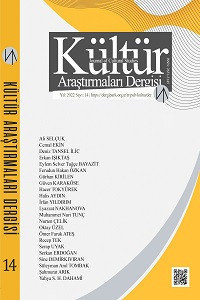Bedenler Neye Sahiptir?
Hafıza çalışmaları, unutmanın aynı zamanda yeni kimliklerin yaratılmasında önemli bir bileşen olarak ortaya çıkabileceğini ileri sürdüğünden, buna dini kurumsallaşma çerçevesinde oldukça meydan okunmakta ve karşı çıkılmaktadır. Kültürel hafızayı oluşturan bilgi, bir iktidar yapısıdır ve iktidar, bilgiyi sürdürmek için sembolik kodları zorlar. Başka bir deyişle, kültürel semboller hafızayı korur ve durumların tanımlarını güçlendirir. Bazı bedenlere atfedilmiş kurumsallaşmış anlam ideolojilerin ve oluşumların devamı için kayda değer bir araç olarak karşımıza çıkmaktadır. İster beton formunda ister bir vücut parçası olsun, kutsal sakinliği ile bir beden, geçmişin hafızası ile geleceğe iletimi arasında bir ilişki yaratır. Bedenlerin nasıl sadece kurumsallaşmaya değil aynı zamanda bir toplumsal cinsiyet sürecine de tabi olduğunu düşünmek de eşit derecede değerlidir. Bu bağlamda, bazı dini tören ve ritüellerin, kolektif hafızayı sürdürmedeki son derece yapılandırılmış güçleriyle birlikte uygulanmasını araştırmayı hedefliyorum. Marian ikonografisi, azizlerin imgeleri ve kalıntıları bedenlerin tezahürü yoluyla kültürel hafızaya katkıları bağlamında incelenmiştir.
Anahtar Kelimeler:
Beden Antropolojisi, Şekillenme, Kolektif Hafıza, Kurumsallaşma, İdeoloji
What Do Bodies Possess?
As the memory studies argue that forgetting can also emerge as a significant component in the creation of new identities, this is, however, rather challenged and opposed within the framework of religious institutionalism. The knowledge that constitutes the cultural memory is a construct of power, and power enforces symbolic codes to maintain the knowledge. In other words, the cultural symbols maintain the memory and reinforce the definitions of situations. The institutional significance attached to certain bodies suggest an astonishing instrument to sustain ideologies and the history of particular constitutions. Whether to be concrete or a relic, a body, with its sacred tranquility, creates an affiliation between the memory of the past and its transmittance toward the future. It is equally worth to consider how bodies are not only subject to institutionalization but also to a process of gendering. In this regard, I aim to explore the implementation of certain sacraments and rituals together with their highly structured power in sustaining the collective memory. Marian iconography, images and relics of saints are also examined insomuch as they foster the cultural memory through the manifestation of bodies.
___
- Assmann, Aleida (2004). Tid och tradition: Varaktighetens kulturella strategier [Time and Tradition: Cultural Strategies of Duration]. (Trans. Peter Jackson) Nora: Nya Doxa.
- Assmann, Aleida (2006). "Memory, Individual and Collective”. The Oxford Handbook of Contextual Political Analysis. (Eds. Robert E. Goodin and Charles Tilly). Oxford: Oxford UP, 210-224.
- Assmann, Jan (2006). Religion and Cultural Memory. Stanford: Stanford University Press.
- Assmann, Jan (2011). “Communicative and Cultural Memory”. Cultural Memories. Knowledge and Space (Klaus Tschira Symposia) vol 4. (Eds. Meusburger P., Heffernan M., Wunder E.). Springer, Dordrecht.
- Assmann, Jan (2011). Cultural Memory and Early Civilization: Writing, Remembrance, and Political Imagination. Cambridge: Cambridge University Press.
- Bellah, Robert N. et al. (1985). Habits of the Heart: Individualism and Commitment in American Life. Berkeley (Calif.): University of California Press.
- Burke, Kenneth (1950). A Rhetoric of Motives. New York: Prentice-Hall.
- Carrithers, Michael et al. (1986). Founders of Faith. Oxford: Oxford University Press.
- Carroll Robert et al. (eds.) (1998). The Bible: Authorized King James Version. Oxford: Oxford University Press.
- Connerton, Paul (1989). How Societies Remember. Cambridge: Cambridge University Press.
- Connerton, Paul (2008). “Seven Types of Forgetting”. Memory Studies 1 (1): 59−71.
- Csordas, Thomas J. (1990). “Embodiment as a Paradigm for Anthropology”. Ethos, 18: 5–47.
- Foucault, Michel (1978). The History of Sexuality, V. 1: An Introduction. New York: Vintage Books.
- Fuchs, Thomas (2017). “Collective Body Memories”. Embodiment, Enaction, and Culture. (Eds. Durt, C. and others). Cambridge MA: MIT Press, 333–352.
- Halbwachs, Maurice (1980). The Collective Memory. New York: Harper & Row.
- Halbwachs, Maurice. (1992). On Collective Memory. Chicago and London: The University of Chicago Press.
- Hervieu-Léger, Danièle (2000). Religion as a Chain of Memory. (Trans. from La religion pour mémoire by Simon Lee). New Brunswick, New Jersey: Rutgers University Press.
- Misztal, Barbara A. (2003). Theories of Social Remembering. Maidenhead, Philadelphia: Open University Press.
- Murphy-O'Connor, Jerome (2008). The Holy Land. New York: Oxford University Press.
- Narvaez, Rafael F. (2006). “Embodiment, Collective Memory, and Time”. Body and Society, 12: 51–73.
- Nora, Pierre (1989). “Between Memory and History: Les Lieux de Mémoire”. Representations, 26: 7–25.
- Rappaport, Roy A. (1999). Ritual and Religion in the Making of Humanity. Cambridge: Cambridge University Press.
- Sakaranaho, Tuula (2011). “Religion and the Study of Social Memory. The Finnish Society for the Study of Religion”. Temenos, 47-2: 135–58.
- Terdiman, Richard (1993). Historicizing Memory, Present Past: Modernity and the Memory Crisis. Ithaca, NY: Cornell University Press.
- URL-1: Associated Press. 2013. "Vatican displays Saint Peter's bones for the first time”. The Guardian. https://www.theguardian.com/world/-2013/nov/24/vatican-st-peters-bones-display-pope-francis
- URL-2: "Boy, 15, nailed to a cross as Filipinos whip and crucify themselves in gory Good Friday ritual". Daily Mail. London. 2008-03-22. Retrieved January 15, 2020.
- URL-3: Catechism of the Catholic Church. 1994. Retrieved from http://www.vatican.va/archive/ccc_css/archive/catechism/p2s2c1a1.html.
- URL-4: Francis, Pope. 2014. General Audience. Retrieved from https://w2.vatican.va/content/francesco/en/audiences/2014/documents/papa-francesco_20140108_udienza-generale.html.
- ISSN: 2651-3145
- Yayın Aralığı: Yılda 4 Sayı
- Başlangıç: 2018
- Yayıncı: Mehmet Ali YOLCU
Sayıdaki Diğer Makaleler
Kültürel Bellekten Elektronik Ortama: Kültür Aktörlerinin Yeni Varlık Alanı Olarak Hazır Mesajlar
Azerbaycan Muğam Mirasının Notasyon Tarihi
"Estudio en Lila" Romanında İspanyol Toplumu ve Kadın
Klasik Dönem Polonya'da Katolikliğin İnşasına Sosyolojik Bir Yaklaşım
Dorothy NOYES, Çevirmen: Tuğba AYDOĞAN
Sosyal Medya Salgını: Türkiye'de Korona'nın Mizahi Yönü
Kilis Halk Hekimliğinde Tedavi Yöntemleri ve Uygulamaları
Kamusal Mekanın Göstergebilim Bağlamında İncelenmesi: İstanbul Eyüp Sultan Meydanı
